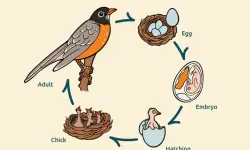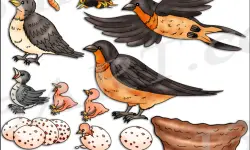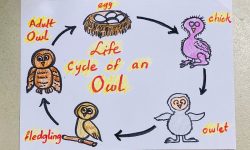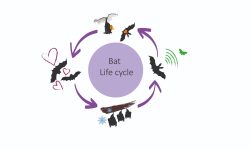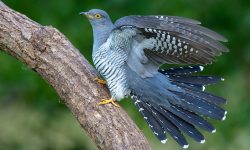California is home to more than just seagulls and hawks—its skies, forests, deserts, and cities are shared by a remarkable variety of pigeons and doves. While some species like the Rock Pigeon are common fixtures in urban life, others like the Band-tailed Pigeon haunt forest canopies far from human eyes. From tiny ground-dwellers in the desert to bold invaders from overseas, these birds belong to the order Columbiformes and offer surprising diversity in behavior, appearance, and ecology. This guide introduces all 13 pigeon and dove species recorded in California, including both residents and rare vagrants, through the lens of their distribution, conservation status, visual traits, and distinctive calls.
1.Rock Pigeon (Columba livia)
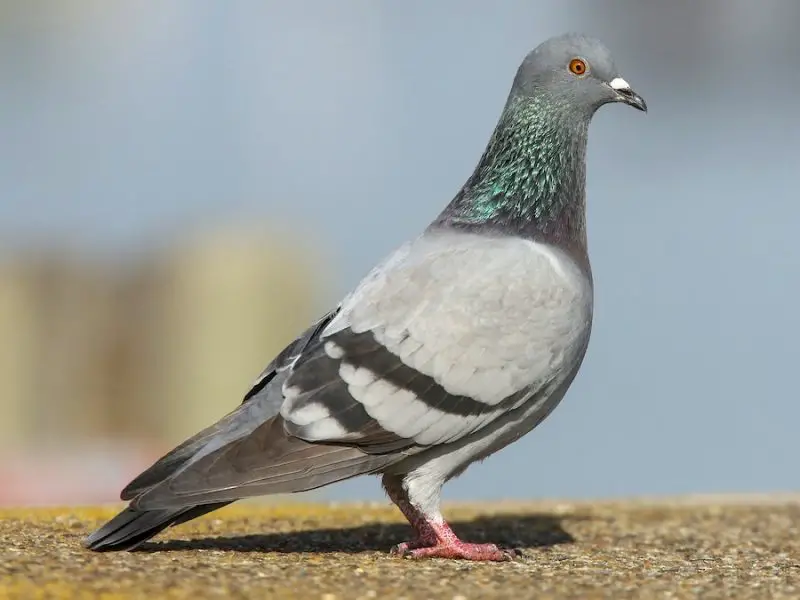
Distribution in California
The Rock Pigeon is widespread across urban, suburban, and agricultural areas throughout California. It thrives in major cities like Los Angeles, San Francisco, and Sacramento, nesting on buildings, bridges, and ledges. It also gathers in large numbers around grain silos and farms in the Central Valley. Rarely found in natural or forested habitats.
Conservation Status
Introduced and non-native. Rock Pigeons are not protected under state or federal law. Populations are stable to overabundant and often considered urban pests.
Identification
A stocky bird with variable plumage. Most have gray bodies, iridescent green and purple neck feathers, black wing bars, and orange-red eyes. Urban populations show a wide range of color morphs including white, brown, and speckled.
Sound
Soft, rhythmic cooing: “coo-oo, coo, coo”, commonly heard in city settings. Their wings produce a sharp clapping or whirring sound when taking flight, especially in enclosed spaces.
2. Band-tailed Pigeon (Patagioenas fasciata)
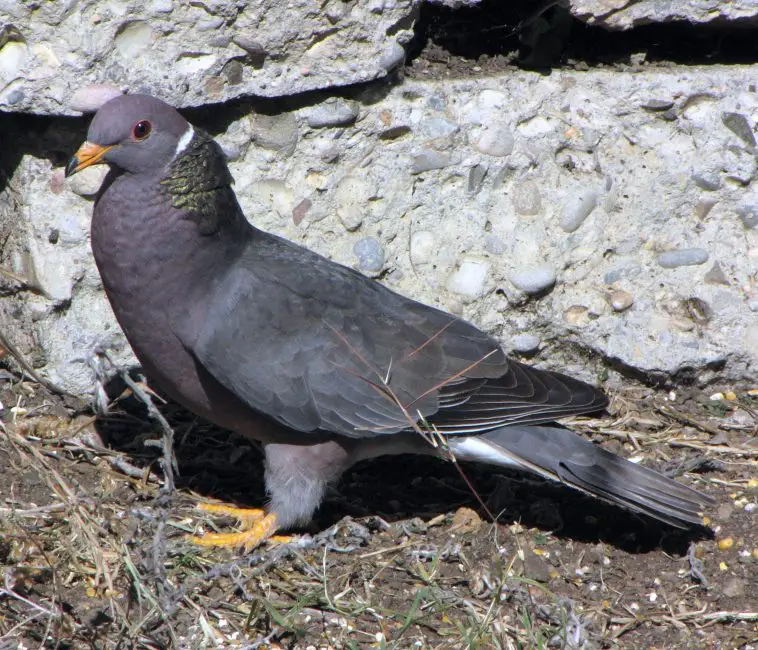
Distribution in California
This native pigeon is found in California’s coastal ranges, Sierra Nevada, and foothill forests, especially in oak woodlands and moist conifer forests. It is more common at higher elevations during summer and may move to lower areas in winter.
Conservation Status
Classified as a California Species of Special Concern. Once widespread, its numbers have declined due to habitat loss and reduced access to mineral springs, which are essential for its diet.
Identification
A large, sleek pigeon with soft gray plumage, a white crescent on the nape, yellow bill with black tip, and a broad tail with a pale terminal band. More elegant in shape than city pigeons.
Sound
A deep, low “whooo-uh, whooo” hoot, often mistaken for an owl. Calls are usually heard from treetops and can be hard to detect.
3. Mourning Dove (Zenaida macroura)

Distribution in California
The Mourning Dove is one of the most widespread and numerous birds across California. It thrives in deserts, grasslands, agricultural fields, suburban gardens, and even dense urban areas. From coastal regions to inland valleys, it is a common year-round resident throughout the state.
Conservation Status
Listed as Least Concern, with a stable and abundant population. Its adaptability to human-modified landscapes and prolific breeding make it one of North America’s most successful dove species.
Identification
A slender dove with soft brown plumage, a long, pointed tail with white edges, and distinct black spots on the wings. Its swift, straight flight and streamlined body distinguish it from other pigeons and doves.
Sound
Known for its mournful, flute-like cooing, typically rendered as: “coo-OOO-ooo, ooo, ooo.” This iconic sound is often heard during early mornings and is one of the most recognizable bird calls in North America.
4. Eurasian Collared-Dove (Streptopelia decaocto)
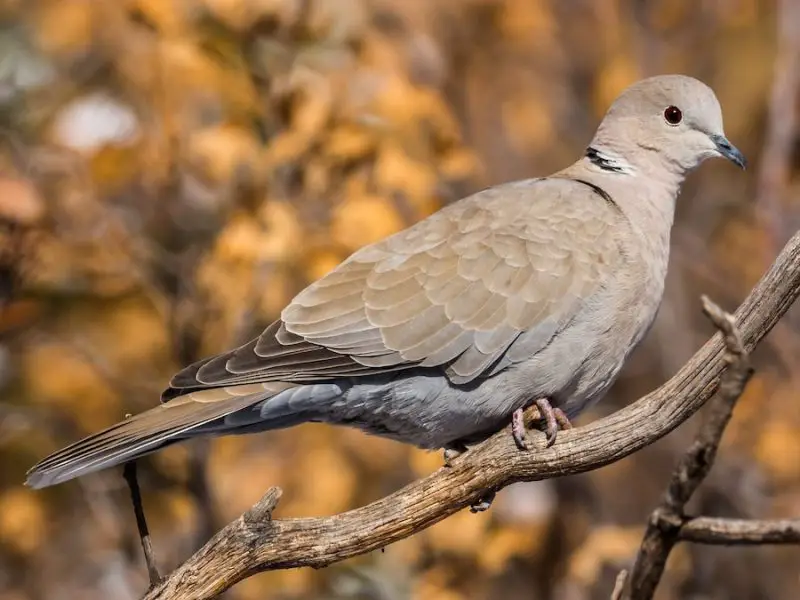
Distribution in California
Since the early 2000s, the Eurasian Collared-Dove has rapidly expanded its range across California. It is now common in Central Valley towns, Southern California suburbs, agricultural zones, and even some foothill communities. Its success is linked to bird feeders, open landscapes, and urban growth.
Conservation Status
An introduced and naturalized species. It is not protected under state or federal law and is not actively managed, though biologists monitor its spread due to its potential impact on native doves.
Identification
A pale gray dove with a distinct black half-collar on the back of the neck, dark eyes, and a square-tipped tail. It is noticeably larger and bulkier than the Mourning Dove, with slower, more deliberate wingbeats.
Sound
A loud, rhythmic “coo-COO-coo”, typically repeated in groups of three. Its call is deeper and more mechanical than those of native species, and often heard from rooftops, utility poles, or exposed branches.
5. White-winged Dove (Zenaida asiatica)
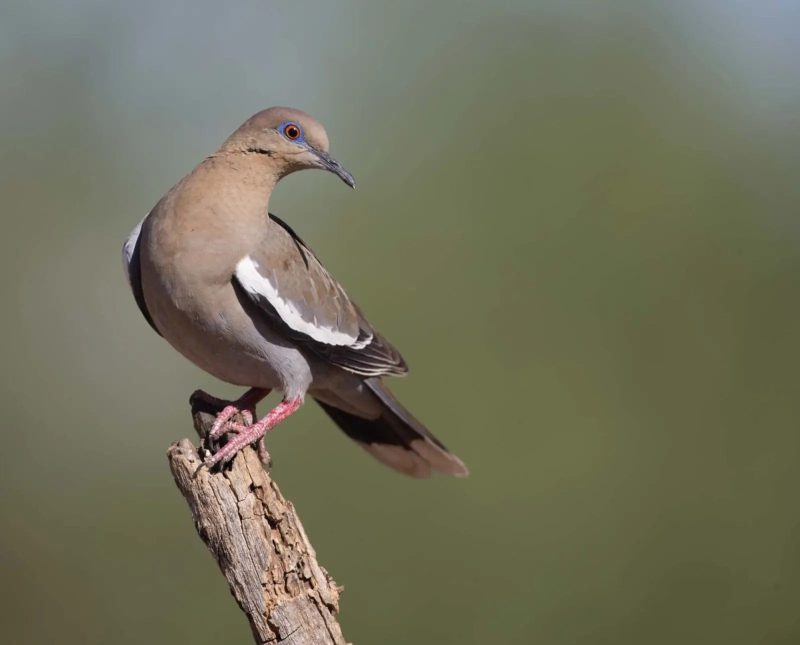
Distribution in California
The White-winged Dove is primarily found in southeastern California, especially along the lower Colorado River, the Imperial Valley, and desert towns. It also occurs occasionally in San Diego County and the Coachella Valley, with a slow but steady expansion northward due to urban landscaping and citrus farming.
Conservation Status
Considered secure within California, though its range is geographically limited. Populations remain stable and are expected to grow as suitable habitat and food sources increase in desert communities and irrigated areas.
Identification
A medium-sized dove with gray-brown plumage, striking white wing patches, and red-orange eyes. In flight, the bold white wing edges are highly visible, giving the bird a distinctive look compared to native doves.
Sound
Its call is a rhythmic, owl-like hooting phrase that sounds like “who-cooks-for-you?”, often repeated from exposed perches during the breeding season. The sound carries well in desert habitats.
6. Common Ground Dove (Columbina passerina)
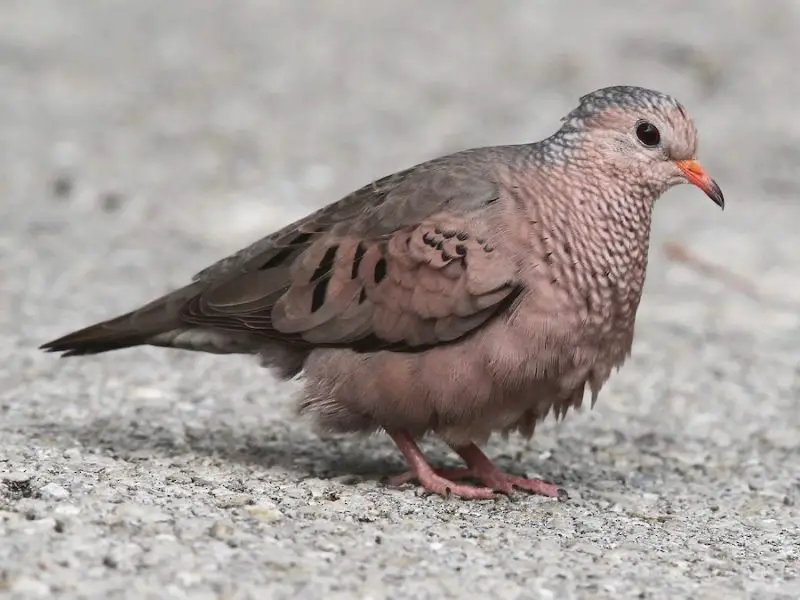
Distribution in California
The Common Ground Dove is restricted to southeastern California, especially in desert scrublands along the lower Colorado River Valley and southern San Diego County. It prefers dry, open habitats with scattered shrubs and sandy soils, often near mesquite, creosote, or agricultural edges.
Conservation Status
An uncommon resident with a stable but limited population. It is sensitive to habitat disturbance, especially from development, grazing, and invasive plants in arid ecosystems.
Identification
California’s smallest dove, barely larger than a sparrow. It has brownish-gray plumage, a scaly appearance on the chest, a short, square-tipped tail, and a compact, rounded body. Its wings show a reddish flash in flight.
Sound
Its call is a soft, mechanical “coo-coo-coo”, delivered at a flat pitch. The sound is quiet and often overlooked unless you’re nearby in a quiet desert setting.
7. Inca Dove (Columbina inca)
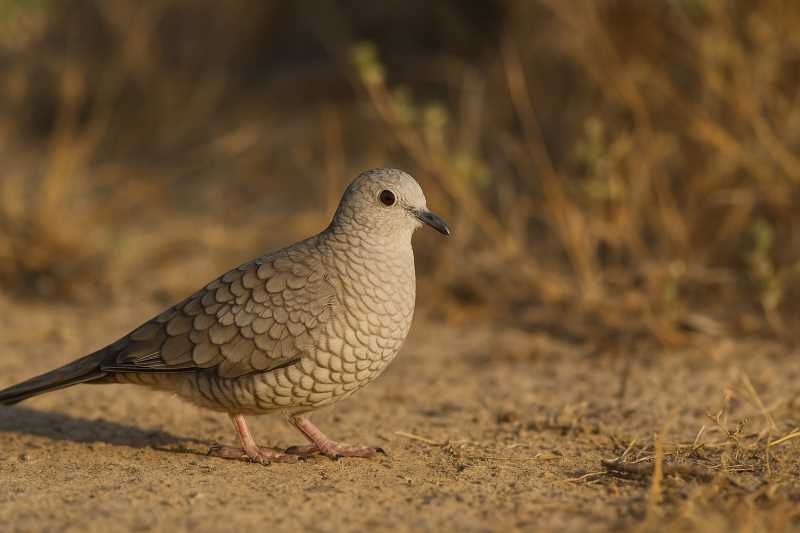
Distribution in California
The Inca Dove is an uncommon and localized species in Southern California, particularly near the Mexican border. It is most frequently observed in Imperial and San Diego Counties, often around residential neighborhoods, parks, and urban gardens. Its range is slowly expanding due to climate adaptation and human development.
Conservation Status
This species is not considered at risk, though it remains uncommon and patchily distributed. It is a relatively recent arrival to California and is closely monitored by birders as it pushes further north into the southwestern U.S.
Identification
A small dove with pale grayish-brown plumage, marked by dark feather edges that give a distinctive scaly appearance. It has a long, slender tail and shows rusty-red underwings in flight. Its size and unique pattern make it easy to separate from other doves.
Sound
Famous for its mournful, drawn-out call that sounds like “no-hope”, slowly repeated from low rooftops or exposed perches. This haunting vocalization is most often heard during early mornings in warm suburban areas.
8. Spotted Dove (Spilopelia chinensis)
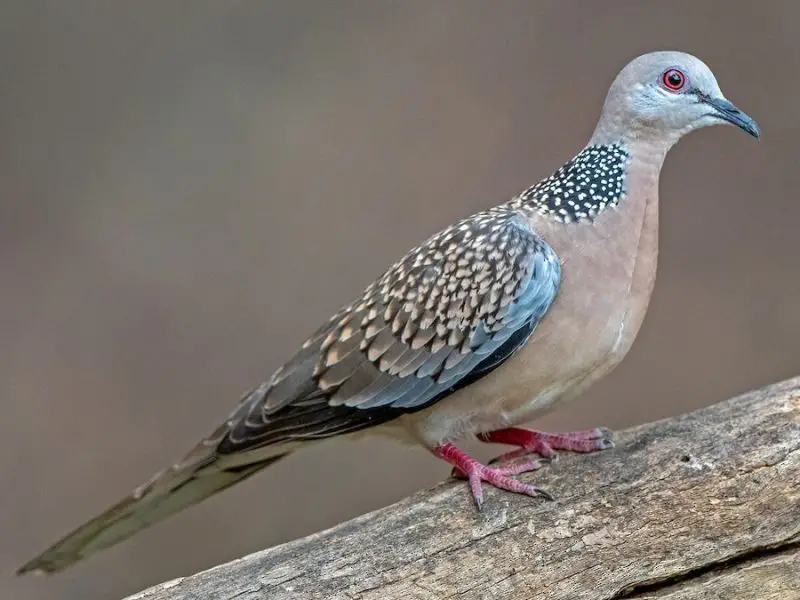
Distribution in California
The Spotted Dove was once common in urban Southern California, particularly in Los Angeles, Orange County, and surrounding suburbs. However, it has become increasingly rare in recent decades, with most sightings now limited to older residential neighborhoods and city parks.
Conservation Status
An introduced species in California, the Spotted Dove is now in sharp decline, likely due to competition from the rapidly expanding Eurasian Collared-Dove. It is not protected and may soon disappear entirely from the state without intervention.
Identification
A large, soft-colored dove with warm brown plumage, a distinctive white-spotted black patch on the sides of the neck, and a long, graduated tail. Its calm demeanor and elegant appearance once made it a familiar sight in gardens and patios.
Sound
Its song is a series of bubbling, mellow coos that rise and fall gently: “coo-coo-croo-croo.” The tone is softer and more musical than that of Eurasian Collared-Doves and is often heard from rooftops or fence posts during quiet mornings.
9. Ruddy Ground Dove (Columbina talpacoti)

Distribution in California
The Ruddy Ground Dove is a rare vagrant in California, occasionally observed in southern desert regions, especially the Imperial Valley and areas near the Mexican border. Most sightings occur during late fall or winter, often following weather events that push tropical species northward.
Conservation Status
This species is not established in California and is considered a tropical stray. It has no breeding population in the state and is monitored primarily by birders and regional rare bird committees.
Identification
A small, compact dove with rounded wings and a short tail. Males are reddish-brown, while females are paler with subtle scaling. In flight, their fluttery, low-level motion resembles other ground doves but with slightly richer tones.
Sound
A quick, flat-pitched “coo-coo-coo” repeated in a steady rhythm. The tone is higher-pitched and thinner than the Common Ground Dove, and often heard in low vegetation or on the ground in open habitats.
10. African Collared-Dove (Streptopelia roseogrisea)
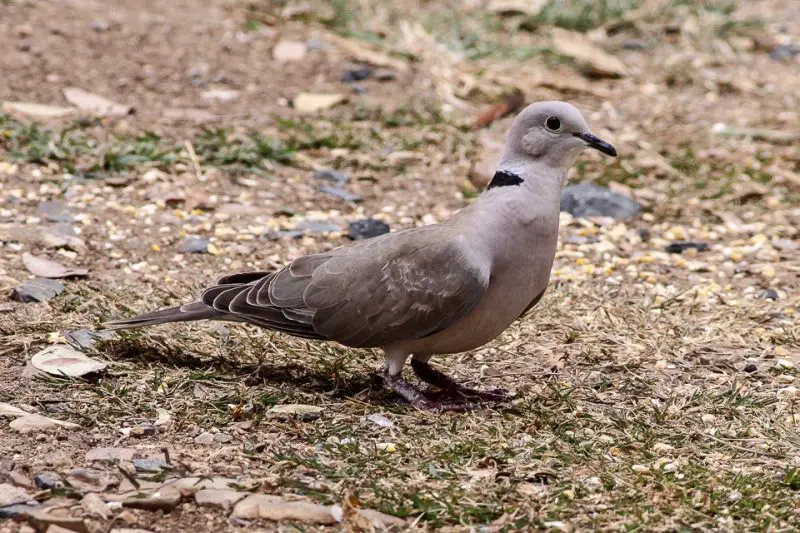
Distribution in California
The African Collared-Dove is a rare escapee in California, occasionally seen near aviaries, suburban neighborhoods, or areas where doves have been released. It is not considered a naturally occurring species in the wild and does not have an established population in the state.
Conservation Status
This bird is a feral descendant of domesticated doves, often confused with the Eurasian Collared-Dove. It is not protected or monitored by wildlife agencies in California and is usually noted only in local birding records.
Identification
Slightly smaller and paler than the Eurasian Collared-Dove, with a narrow black collar on the nape and light gray to pinkish plumage. It appears more delicate and often exhibits a gentler, less wary behavior than truly wild doves.
Sound
Its vocalizations are nearly indistinguishable from the Eurasian Collared-Dove’s familiar “coo-COO-coo”, though calls are less frequent and quieter in the wild, likely due to its domestic origins.
11. Ringed Turtle-Dove (Streptopelia risoria)
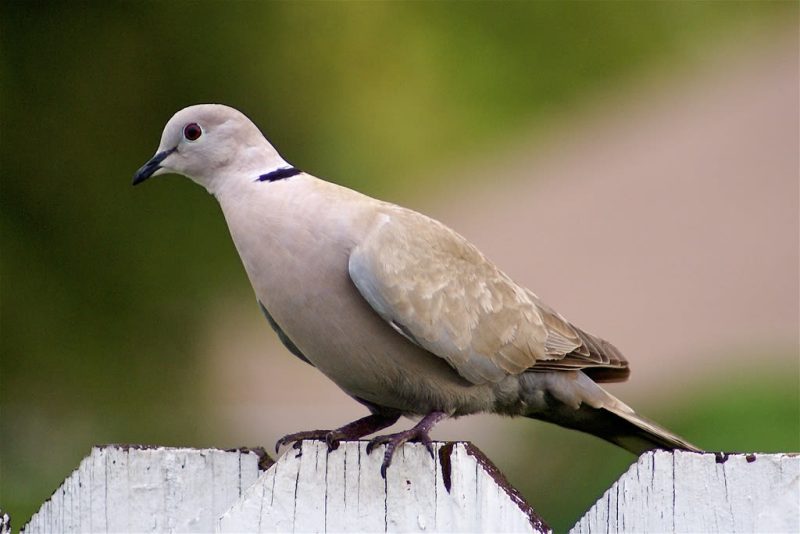
Distribution in California
The Ringed Turtle-Dove is a domesticated species occasionally seen in the wild as an escapee. Sightings typically occur in urban neighborhoods, especially near pet stores, backyard aviaries, or areas where ceremonial releases take place. It does not survive long in the wild and is not a naturally occurring bird in California’s ecosystems.
Conservation Status
Not protected or recognized as a wild species. This dove is a fully domesticated form of African Collared-Dove, with no breeding populations in the wild. It is not tracked by conservation agencies and is considered non-native and non-establishing.
Identification
A small, pale dove with pinkish-gray or creamy plumage, a thin black collar on the nape, and dark eyes. Its appearance closely resembles the African Collared-Dove, though it tends to appear tamer and more delicate due to its domestic breeding.
Sound
Soft, gentle cooing phrases that resemble the Eurasian Collared-Dove’s calls, but are quieter, slower, and more musical in tone. Most vocalizations occur when the bird is calm or near familiar surroundings.
12. Red-billed Pigeon (Patagioenas flavirostris)
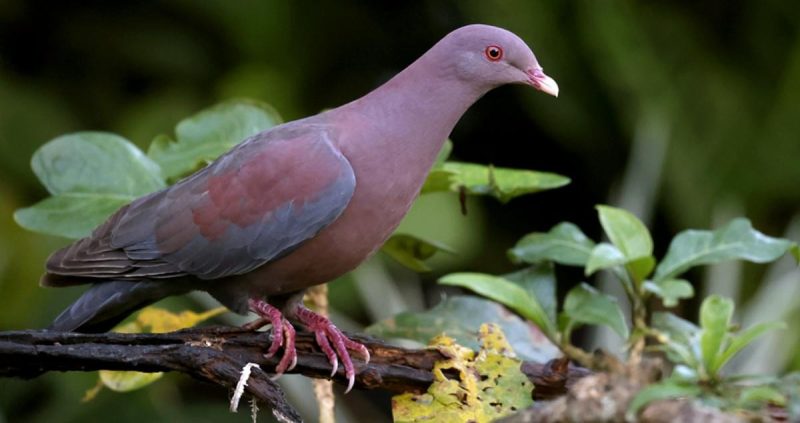
Distribution in California
The Red-billed Pigeon is a rare vagrant in California, occasionally appearing in the southernmost parts of the state, such as San Diego County or desert oases near the Mexican border. Most sightings occur in late summer, often following tropical weather systems or during seasonal movements from its native range in Mexico and Central America.
Conservation Status
This species is not established in California and is considered a casual visitor. It is tracked by birders and local rare bird committees, but not protected or managed as a regular part of the state’s avifauna.
Identification
A large, heavy-bodied pigeon with rich reddish-purple plumage, especially on the head and chest. It has a distinctive red bill with a yellow tip, dark wings, and red eyes. Its size and deep coloration distinguish it from other pigeons in the region.
Sound
The vocalization is a low, booming “who-who-who” call, often delivered slowly from high perches. While common in its native tropical forests, its voice is rarely heard in California due to its limited and infrequent presence.
13. Passenger Pigeon (Ectopistes migratorius) – Extinct
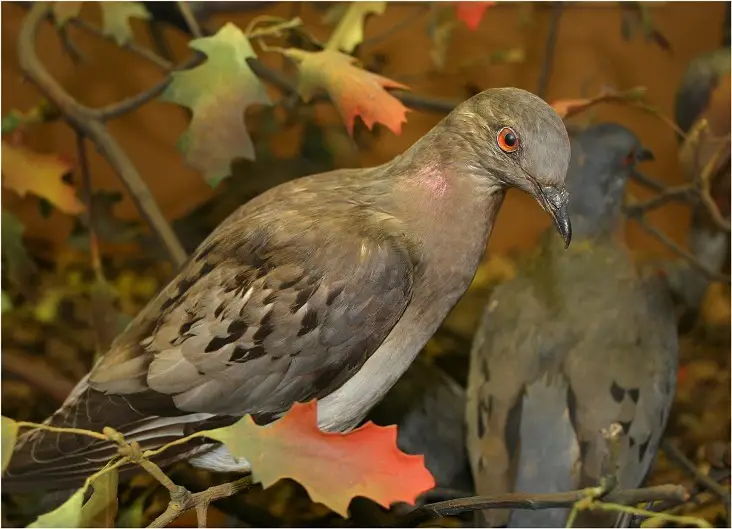
Distribution in California
The Passenger Pigeon was rarely observed in California, with only scattered historical records suggesting it passed through in small numbers during migration. Most of its vast migratory range was concentrated east of the Rocky Mountains, making sightings west of the Rockies—including in California—uncommon and incidental.
Conservation Status
This species was officially declared extinct in 1914, following the death of the last known individual, “Martha,” at the Cincinnati Zoo. Once the most abundant bird in North America, with populations in the billions, it was driven to extinction by intense commercial hunting, habitat loss, and the collapse of massive breeding colonies.
Identification
A medium-sized pigeon with long, tapered wings and tail, bluish-gray upperparts, and a rosy breast. Males had a more vivid color pattern than females. Its streamlined body and swift flight made it visibly distinct from modern urban pigeons. The last confirmed wild individuals were seen in the early 1900s.
Sound
Passenger Pigeons were known to produce soft coos and loud wing whistles in flight when moving in massive flocks. Unfortunately, no audio recordings exist, but written accounts describe the sound of their passing flocks as thunderous and overwhelming, often darkening the sky for hours.
Conclusion
Pigeons and doves are more than just park dwellers—they are a diverse and complex part of California’s avian community. Some, like the Band-tailed Pigeon, represent fragile remnants of wild forest ecosystems. Others, like the Eurasian Collared-Dove, are newcomers rapidly reshaping bird communities across towns and fields. And then there are the vagrants and extinct ghosts of the past, like the Red-billed and Passenger Pigeons, whose presence reminds us of nature’s dynamism and fragility. Whether in cities, deserts, or mountains, California’s pigeons offer beauty, subtlety, and a fascinating glimpse into the state’s evolving biodiversity.

